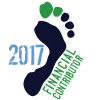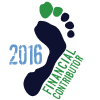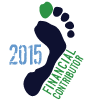Healthy People = Barefoot People
By Dr. Steve Gangemi, a.k.a., Sock Doc
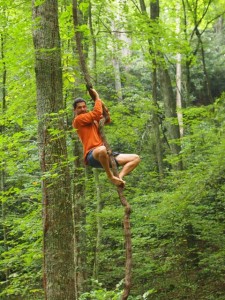
Climbing Definitely Easier Barefoot
Humans should be able to function barefoot from birth until death, (barring some birth defect, infection, or trauma of course), though sadly many people are unable to run, walk, or even stand for even a few minutes barefoot without discomfort, pain, or general uneasiness. Many people have essentially lost their ability to support themselves without support, (shoes or shoes with orthotics), either because of poor biomechanics or an underlying health problem. I’d like to think at least walking barefoot is possible for everyone but realize this unfortunately is not always the case and is even more of an unrealistic expectation for those wishing to run barefoot. Sure there are obvious health problems such as people who are diabetic with neuropathy who may need something under their feet, but many other people with various health conditions cannot shed their footwear because they need the support of their shoes or else their feet will ache, hurt, or even become injured.
Is Barefoot for Everyone?
I don’t think there is a debate on how we were meant to run, or even walk for that matter, but immediately switching back to barefoot the way our ancestors were living millions of years ago is often not a wise idea. Humans are not meant to over-stride and land on their heels when running which today’s typical shoe promotes. Even while walking, typical footwear will elicit more of a heel strike, extended stride, and an unnatural and inefficient push-off with the foot. A minimalist or barefoot walker will land softly with a shorter stride and efficiently roll off the foot.
Modern life has also changed how we move and of course, live our daily lives. In addition to the harmful influence of modern walking and running shoes, common daily stresses such as long work hours, family demands, and poor food choices have created unhealthy changes in most human feet which further contribute to gait disturbances and other body aches, pains, and ailments.
Health is not merely the absence of some pathological disease. Many people think they are healthy but often they are not as healthy as they could be. Do you sleep well throughout the night without awakening and wake up feeling good without aches and pains? If not, I’d define that as poor health. Do you take any medication – whether it’s an anti-inflammatory, hormone replacement, a drug to wake up, to go to sleep, or to have sex? Taking any medication is a sign of poor health. Do you lack energy – both physically and mentally during the day? How about your digestion? Are you one of the many women (and sometimes guys) like those I see in the office who think it’s normal to have a bowel movement just a couple of times a week? Definitely not healthy. Do you need to wear an orthotic in order to walk without pain or some type of traditional footwear with support and “cushion” so you can walk, stand, or even exercise? If you do you’re definitely not healthy from my perspective.
A healthy person may not wish to go barefoot, but they should be able to. Sure if they’ve been wearing traditional shoes for some time they will need to transition into barefoot, but a healthy person can achieve this (and should, to further improve their health). An unhealthy person may be able to achieve the same feat, but it will be much more difficult for them and for many, impossible. One has to work their way towards health and to barefoot; they are both processes. For many, neither may be easy. Health and barefoot complement each other; it is much harder for an unhealthy person to be barefoot for a prolonged period of time or to the degree of a healthy individual, (such as running and jumping un-shod).
A barefoot or minimalist person still may have health problems, but I’d say overall less of these individuals do than those who wear the typical thick oversupportive shoes and especially orthotics. For those of you who may think that going barefoot does not have a significant impact on how you move and feel during the day I would ask how many of you are actually barefoot for a prolonged period of time each and every day? I have yet to meet a person who is often barefoot and no longer wears the typical shoes we see today who has not told me that they feel more vibrant, agile, and overall body awareness than when they were shod.
There’s More to Barefoot than Just the Feet
Each foot is home to thousands of nerve endings and the information they receive and pass on to the rest of the body is anything less than extraordinary. When your foot feels the ground, (or whatever is below it, including any footwear), the thousands of touch receptors in the nerve endings feed back to the rest of the entire nervous system. Since your nervous system runs your entire body, any foot impairment, dysfunction, injury, pain, or improper footwear can not only hinder you directly, (such as lower leg function and balance), but your entire health.
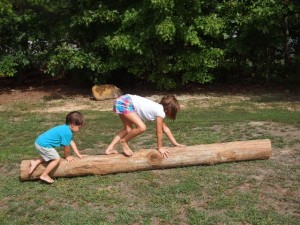
Sock Doc Kids - Ava Mae and Paxton Usually Barefoot
Walking or running barefoot is an ideal way to improve your proprioception (sense of position) and kinesthetic sense (the feedback your nervous system receives from your feet). Natural, unaltered motions of the human body provide optimal neurological input and increase blood flow to the brain improving the health of the nervous system. This increased blood flow provides more nutrients and oxygen to the brain and essentially the entire body thereby improving the health of the un-shod person. This is especially important in a developing child and is why a child should be barefoot as much as possible, inside and outside.
Barefoot Won’t Cure Cancer or Other Diseases, But it May Improve Your Health
There are some people with health issues who have no foot or leg problems, balance issues, or any body aches or pains. Are health problems and foot problems always related? Of course not. Do the feet always need to be examined and treated to get the person well from their ailment? Not necessarily – that depends on the individual (but examining foot health should be standard). The concept here is more that if you have a health problem yet you feel like your feet are already in excellent condition, then perhaps you can help your health problem by going barefoot more, (or start to if you’re not already), because of the amazing connection between your feet with your nervous system, fascia, and gait. Though, to reiterate, this type of person is rare, and often I find that once the person does try to go barefoot, they cannot, because they have lost their balance or perhaps they experience pain. They had a problem all along, it was just being supported (masked) by their footwear or perhaps an orthotic device.
But more often the feet will tell you how you’re doing overall from a health perspective. Regardless of where the problem is, the feet will eventually pick up on it. Listen to what they have to say. Often they’re telling you that you’re unable to deal with the amount of stress you’re under. This stress could be emotional, such as family issues, work stress, or expectations you or others have. The stress could be chemical/nutritional, perhaps from a diet high in refined carbohydrates, too much caffeine, artificial flavorings, smoking, or environmental toxins. The stress could be physical from an injury – not just one you perhaps sustained last week but even one from when you were five years old! Your body can remember many of those injuries, regardless if they still bother you. They can and do affect fascia, gait, and the nervous system. The physical stress could be from something on your feet you shouldn’t be wearing. Often people have an accumulation of many stressors and they build up over time. They still feel healthy, though their body is slowly trying to adapt to the stress and compensate as more is added. Eventually you wake up tired every morning, or go out for a run or walk and your knee starts to hurt, or you get indigestion when you eat. Traditional medicine is great at diagnosing what is wrong with someone – the end symptom, you may call it. You have “chronic fatigue” or “restless leg syndrome” or “tendonitis” or “GERD”. They all sound so intriguing but they do absolutely nothing to resolve the problem. This is because it is always more important to diagnose the processes gone awry that lead up to the symptom(s). Often there are many processes that must be investigated and treated accordingly.
By wearing over supportive shoes, arch supports, orthotics, or other devices, the person who has lost their health is only masking symptoms. It is symptom orientated – not a true correction of the underlying problem. I get a chuckle when a natural health care provider who touts themselves as “treating the cause and not the symptom” puts their patient in an orthotic. And let’s not be misled to think that “fallen arches” and flat feet need orthotics, they don’t.
Should You Venture Into Minimalism if You’re Not Injured or Having Any Problems?
If you’re not injured and could care less about performance should you get out of your traditional footwear or running shoes? Though many advise just to keep doing what you’re doing I don’t support that position. You will only truly be sure if your feet and other areas of your body are strong and healthy if you venture out of your footwear. If you have trouble doing so it’s an indication that there is a problem you’ve been supporting just as if you were not feeling elbow pain every time you played tennis because you wore a brace, for example. Just because you don’t have pain, weakness, or discomfort doesn’t mean a problem is not there. Ask yourself WHY you can’t be without your supportive shoes or supportive foot braces. This doesn’t mean you go barefoot right away, but you should enter the realm of minimalism just to get an idea of where you’re at. Stronger feet and lower legs and more body awareness are definitely possible moving barefoot.
A healthy individual can be barefoot baring some old injury to the foot and they can further improve their health, fitness and overall well-being. If you have a health problem or an injury, investigating the minimalist and barefoot approach may be an essential step in your recovery, and further prevention of that or another problem. As mentioned earlier, barefoot isn’t going to cure a disease you may have –but it will most likely have a noticeable effect on your health and well-being. And also as mentioned earlier, if you don’t think it can have such an effect, how do you really know unless you’ve tried it?
Ready to Make the Change? Transition to Minimalism and Barefoot
Yes too many people are getting injured by switching from their current footwear to minimalist footwear or even barefoot. This gives the traditional medical doctor, podiatrist, or therapist reason to believe that humans today are not meant to be barefoot and we need to protect our feet with more supportive shoes. I get a fair share of hate mail from these people who think that because we don’t live in wild jungles we need support on our feet to get through the day on our “unnatural” surfaces. Though of course I don’t agree with this, the typical unhealthy person and/or the person who has always worn supportive footwear or orthotics can’t just make the shift so drastically. Many of them do, and they get injured, so these doctors and therapists see them in their office and rather than educate the patient on overall health (diet, lifestyle, and foot care), they convince them that barefoot is evil and humans need shoes. This is pretty sad in my opinion, but it’s the standard of our health care system.
You must transition to barefoot slowly and carefully, so you do not become injured. There is no rush! Start just by walking barefoot inside your house as much as you comfortably can. If that’s painful then you can start with a minimalist-type shoe and eventually work out of those to barefoot. It’s okay to alternate between your current traditional shoes and a minimalist shoe/barefoot if you have pain. If you’re wearing orthotics, talk to your prescribing doctor about getting out of them so you can walk naturally again and not support your dysfunction. If that doctor doesn’t think that’s possible for you to rehab your feet in such a way then personally I’d find another doc, unless your situation truly warrants a supportive device (very rare). If you’ve been wearing supportive shoes with orthotics for years the transition is going to take time. Once you can comfortably walk barefoot then work on balancing (one leg) barefoot too for several seconds and then a minute or so at a time. Hard surfaces (tile, hardwood) are okay and advised!
Once you’re walking barefoot inside comfortably then venture outside onto hard, smooth surfaces such as your driveway. Slowly build up time as you comfortably can. Eventually make your way to other surfaces such as grass and gavel. Of course make sure these areas are safe to walk on. If barefoot is bothersome to you outside then use a minimalist shoe at first. Check out the many shoe reviews at the Natural Running Center as well as VIVOBAREFOOT. Remember that different shoes work for different people!
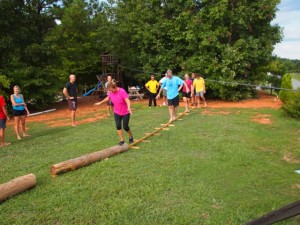
Barefoot Balancing
Once you’re walking barefoot outside comfortably then try a bit of barefoot running on a flat, hard surface – not too much at first or you’re likely to develop sore feet and calves very quickly! If you never run then a minimalist shoe will be more appropriate at first. If you don’t want to or don’t like to run outside barefoot then that is perfectly fine. But do your best to get into a minimalist shoe or “barefoot style” shoe. Continuing to walk barefoot outside, and especially inside, as much as you can, is advised.
If you’re a runner or avid walker then while introducing this barefoot program into your daily routine you should also be transitioning out of your current footwear into a minimalist-type shoe. Think flat, firm, flexible, and wide. This means that the shoe should not have a significant, or any, heel to toe drop, (if you’re coming from a thick heel you will not want to go to a zero-drop shoe immediately), there should be little to no cushion or padding in the sole, and the shoe should not be rigid anywhere – it should bend throughout the shoe and in any direction. The shoe should also be wide at the toe box allowing the toes to naturally splay apart.
Finally, don’t go back to your old shoes! The only unfortunate nuisance with being barefoot and wearing minimalist/barefoot shoes over time is that the typical shoes you were wearing will soon be very uncomfortable on your feet and you’ll need new footwear. Even a 4mm drop may be uncomfortable to an often-barefoot individual. It is for me.
Check out my power point presentation on barefoot and minimalism!
http://sock-doc.com/2012/03/healthy-people-barefoot-people/





